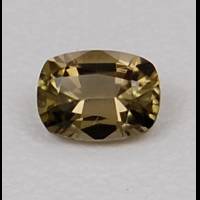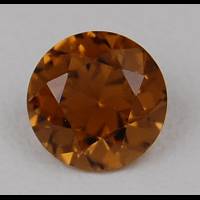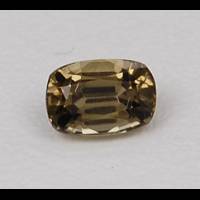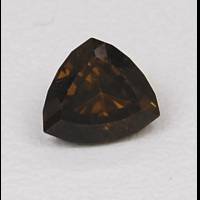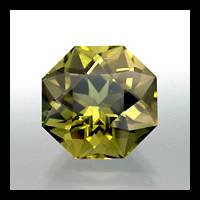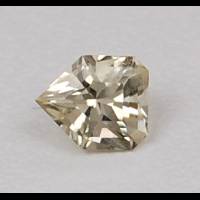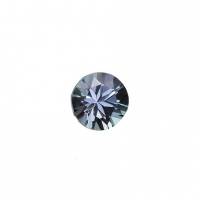Kornerupine

India
1.20 carats
© Mineral Classics
The colour can vary from brown, green to shades of yellow, the material is strongly pleochroic and frequently asteriated (from Burma and Taita Hills, Kenya). Cat's eye effect is due to inclusions of rutile and graphite.
Kornerupine can be faceted or cut into cabochons. Cut stones are up to 20 carats (usually to 3 carats).
Kornerupine Gemstones by Colour
This table shows the variety of hues this gemstone can be found in. Click on a photo for more information.
Kornerupine Gemstones by Size
This table shows distribution of Kornerupine gemstone sizes that are listed on this site. This can give a good indication as to the general availability of this gemstone in different sizes.
Contributed photos
Lightest:0.08 cts
Heaviest:12.20 cts
Average:2.00 cts
Total photos:13
Do you have a larger Kornerupine? Why not upload a photo?
| General Information | ||||||||||||||||||||||||||||||||||||||||||
|---|---|---|---|---|---|---|---|---|---|---|---|---|---|---|---|---|---|---|---|---|---|---|---|---|---|---|---|---|---|---|---|---|---|---|---|---|---|---|---|---|---|---|
| Chemical Formula |
| |||||||||||||||||||||||||||||||||||||||||
| Physical Properties of Kornerupine | ||||||||||||||||||||||||||||||||||||||||||
| Mohs Hardness | 6.5, Blue Chart Gem Identification (2010) More from other references | |||||||||||||||||||||||||||||||||||||||||
| Specific Gravity | 3.25 to 3.45, Blue Chart Gem Identification (2010) More from other references | |||||||||||||||||||||||||||||||||||||||||
| Cleavage Quality | Good, Gemstones of the world (2001) More from other references | |||||||||||||||||||||||||||||||||||||||||
| Fracture | Conchoidal, Gemstones (2009) | |||||||||||||||||||||||||||||||||||||||||
| Optical Properties of Kornerupine | ||||||||||||||||||||||||||||||||||||||||||
| Refractive Index | 1.660 to 1.685, Blue Chart Gem Identification (2010) More from other references | |||||||||||||||||||||||||||||||||||||||||
| Optical Character | Biaxial/-, Blue Chart Gem Identification (2010) More from other references | |||||||||||||||||||||||||||||||||||||||||
| Birefringence | 0.012 to 0.017, Blue Chart Gem Identification (2010) More from other references | |||||||||||||||||||||||||||||||||||||||||
| Pleochroism | Strong trichroism is common for green variety: green - yellow - reddish brown, Blue Chart Gem Identification (2010) More from other references | |||||||||||||||||||||||||||||||||||||||||
| Dispersion | 0.018, Gemstones (2009) | |||||||||||||||||||||||||||||||||||||||||
| Chatoyancy | Rare star 4, Blue Chart Gem Identification (2010) | |||||||||||||||||||||||||||||||||||||||||
| Colour | ||||||||||||||||||||||||||||||||||||||||||
| Colour (General) | Green, blue-green, brownish-green, greenish-brown, Gemmological Tables (2004) More from other references | |||||||||||||||||||||||||||||||||||||||||
| Causes of Colour | Blue, Cr3+ in octahedral coordination. Green, V3+ in octahedral coordination, Pragmatic Spectroscopy For Gemologists (2011) | |||||||||||||||||||||||||||||||||||||||||
| Transparency | Transparent, Gemmological Tables (2004) More from other references | |||||||||||||||||||||||||||||||||||||||||
| Lustre | Vitreous, Gemstones (2009) | |||||||||||||||||||||||||||||||||||||||||
| Fluorescence & other light emissions | ||||||||||||||||||||||||||||||||||||||||||
| Fluorescence (General) | Usually none; green kornerupine from Kenya: yellow, Gemstones of the world (2001) More from other references | |||||||||||||||||||||||||||||||||||||||||
| Crystallography of Kornerupine | ||||||||||||||||||||||||||||||||||||||||||
| Crystal System | Orthorhombic, Blue Chart Gem Identification (2010) More from other references | |||||||||||||||||||||||||||||||||||||||||
| Habit | Prismatic, Gems, Sixth Edition (2006) More from other references | |||||||||||||||||||||||||||||||||||||||||
| Geological Environment | ||||||||||||||||||||||||||||||||||||||||||
| Where found: | Occurs in boron-rich volcanic and sedimentary rocks subjected to metamorphism, Gems, Sixth Edition (2006) | |||||||||||||||||||||||||||||||||||||||||
| Inclusions in Kornerupine | ||||||||||||||||||||||||||||||||||||||||||
| Common needle-like inclusions: sharp cat's eye (grayish, greenish, black)- Blue Chart Gem Identification, Herve Nicolas Lazzarelli, 2010, p 4 Needle-like crystals, zircons with tension cracks - Gemmological Tables, Ulrich Henn and Claudio C. Milisenda, 2004, p 19 | ||||||||||||||||||||||||||||||||||||||||||
| Further Information | ||||||||||||||||||||||||||||||||||||||||||
| Mineral information: | Kornerupine information at mindat.org | |||||||||||||||||||||||||||||||||||||||||
| Significant Gem Localities | ||||||||||||||||||||||||||||||||||||||||||
| ||||||||||||||||||||||||||||||||||||||||||

